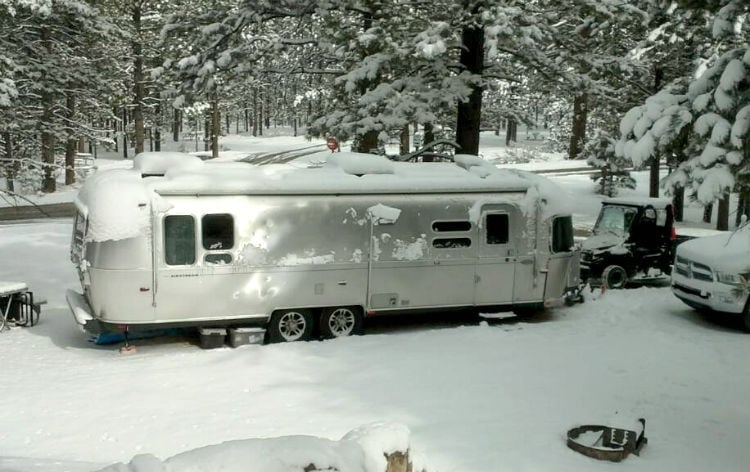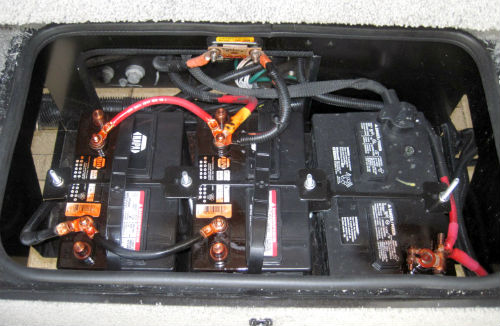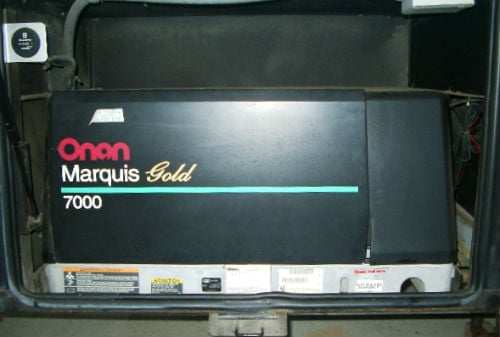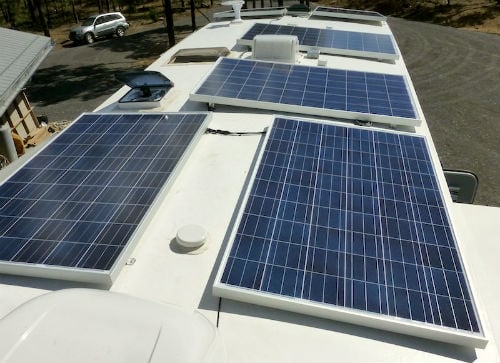If you’re like me, you enjoy using your RV throughout the year, including winter when there are many activities to enjoy.
However, more often than not, electrical hook-ups in a campground aren’t available when winter camping. This leaves your batteries to power your off-season adventure.

With a little research and practice, you will soon learn how to maximize your RVs batteries while winter camping. Photo Courtesy Beach Bum airforums.com
Winter camping and your RV batteries
Preparing for winter camping takes a bit of thought, especially when it comes to figuring out how to power up everything you need.
In the instance where you only have one house battery, forget about winter camping (if an electrical hook-up is not available). As a result, you won’t have enough reserve capacity to keep the systems in your RV operating.

Never let your batteries discharge below 50 percent of the rated capacity. Photo courtesy Cass Sumrall iRV2.com
Two winter battery basics:
- A charged battery has a higher percentage of sulfuric acid than a discharged battery. This means there is less water in the battery’s electrolyte and it’s less likely to freeze. It’s worth noting that a fully-charged battery will freeze if the temperature drops to 55 °F or more. A discharged battery may freeze around 20 °F. For coach owners, verify that the converter/charger charges the house and start battery. Otherwise, your engine battery may not start your rig at the end of your trip.
- Never let your batteries discharge below 50% of the rated capacity. If you do, recharge them. If you let them discharge to lower than 20% capacity, they’ll never charge to full capacity again.
Here’s what you can do to maximize power:
Battery usage is all about amps out and amps in. So, if you draw six amps out, say, running a furnace, you need a way to put those six amps back in. Or, you’ll have to head home when your battery bank is at 50% of its rated amperage capacity.

Photo courtesy Max Hubrich iRV2.com
There are several ways to put amps back in your battery bank, including:
- You can charge them via your tow vehicle or alternator on your motor. This is typically the least efficient, but it is an option.
- Use your solar system if you have one.
- Use a generator to charge your batteries. This can be done via the RVs converter/charger by plugging in the RVs electrical shore power cord to the generators 120 volt AC outlet. Or, if the generator has a 12 volt DC output, hook straight up to the batteries.
To determine the best option, find out what the charge rate is of your converter/charger compared to the DC output of the generator. Then, utilize whatever puts out more amps. Three-stage chargers are also ideal to use.
How to minimize amps:
Now, let’s look at minimizing the amps that are taken out.
The biggest amp draw will be from your furnace. Determine the amperage draw, and then note how long it runs. You can then estimate how many amps were drawn out and how long your charging source will need to replenish those amps.

A solar system is also a viable choice to use if you have one. Photo courtesy Reed Cundiff iRV2.com
As an example: If your furnace draws six amps for every hour it runs (and if it runs about 30 minutes out of every hour) you will need 72 amps/day to recharge your batteries (i.e. six amps per .5 hours x 24 hours in a day = 72amps / day).
If you have a good three-stage charger it can charge at upwards of 40 amps per hour or more. So, to put those amps back in you would have to plug your RV into your generator and run it approximately 1.8 hours (72 amps divided by 40 amps per hour = 1.8 hours)
Other sources of battery drain include 12V lights. You reduce the drain by using LEDs, as incandescent bulbs draw about 1.5 amps while LEDs pull about .15 amps.
Other battery-draining sources include gas leak detectors, TV antenna power boosters, stereos, appliance circuit boards, or refrigerators with heat strips that reduce condensation.
Most are negligible but they can add up to an amp or two per hour. An easy way to determine the amp draw of these items is to pull the fuse in the converter and measure the amp draw between the fuse terminals with a volt-ohm meter. Also, decide if you can eliminate any of these loads safely.
Sufficient battery performance in the winter starts with great battery maintenance all year long. Battery levels should be checked every month at minimum. Battery posts and cables should be cleaned and the battery cells filled to the proper level with distilled water. You should consult your battery manufacturer and/or RV manufacturer to determine if a battery equalization process is available, and what the procedure is for your rig.
It’s important to keep track of all of your battery maintenance. A great tool for this is the online RV maintenance tracking tool, RV LIFE Maintenance. Not only can you keep track of all your battery maintenance, but you can keep all of your other RV maintenance records and documents in one place. You’ll also receive timely reminders via email when maintenance is due. Whether you have a small camper or large class A motorhome, RV LIFE Maintenance can keep track of it all, along with up to two other battery-equipped vehicles, such as a tow car, motorcycle, or four-wheeler.
With a little research and practice, you will soon be able to maximize your RV’s batteries while camping. So, be sure to enjoy winter RV fun and everything that goes along with it on your next adventure!

This article continually mixes up rate (amps) with volume (amp-hours) and even uses acceleration (amps per hour). Amps refers to the rate of use or the rate of charge (the rate that electrical energy is put back into the batteries). Volts is a measure of the potential energy. As one takes electrical energy out of the batteries (amp draw) batteries do lose some potential energy (voltage drop). This article probably does seem to make sense to those that do not understand DC electricity, but it sure is less than true to an engineer.
Perhaps everyone will one day get it 100% right and forget about Amp hours altogether and use watts and watt hours or kilowatts and kilowatt hours instead so it works for everything including battery capacity and appliance ratings regardless of what the nominal voltage your system operates at.
This is great. I love camping. I will follow this for sure.
The author’s 40 amps out/in example is wrong. A generator powering a on board converter or a 3 stage battery charger will NOT recharge your batteries in approximately 1.8 hours. Because converters and battery chargers taper the charging rate as batteries charge, it might take 3 hours or more (using the author’s example.)
This feel good article might get you in serious trouble. Please take the time to research battery types, converter & charger types, and solar systems.
Bill – The article was aimed at entry level dry campers. You are correct it will take longer than stated to FULLY CHARGE your batteries, but if your batteries were only at 85-90% capacity when you started to draw them down the example given is a good rule of thumb as the converter/charger will replace the majority of the amps consumed, getting the user back to where they started. Thanks for commenting.
As a fulltime 5th wheel lifer, I see the need for articles like this.
These articles get the RV’er thinking and upwardly mobilized
to stay functioning in winter and hopefully avoid pitfalls.
In my humble opinion, RV’ers should always have a GOOD
separate generator and fuel to run it incase of emergency.
Problems DO occur and the man with electricity rules!
Even a small generator with spare gas will save the day.
Using it to keep your battery bank topped off is the smart way
to go.
But, if need be, the generator can also be used to power all items
if you are smart enough to have a 10 gallon fuel tank on hand to keep the genny going.
~ peace
Dear Dave,
If you think of electricity flowing through a wire as if it were water flowing through a pipe, then
1 – voltage is the pressure in the pipe,
2 – amperage is the speed at which the water is flowing through the pipe and
3 – wattage is the total amount of water that flowed through the pipe per unit of time.
Best,
Watt-hours, not Wattage.
This comment is nearly completely wrong. The pressure does correspond to the voltage, but… Water and electricity do not follow the same physical laws, but if they did, to patch up this analogy you would have to change it to.
The amount of water flowing per time is the amperage (current). The speed of the water is irrelevant. The same amount of water per time flowing through a bigger pipe would have less speed but not less current.
The amount of power in watts delivered (energy per time) is the pressure (voltage) times the flow rate (current).
The total energy stored or used is the power integrated over time (or power x time if the power is constant) in watt-hours.
Basic article is great… and as can be seen stimulates the mind into…. what if …. conditions.
to add to the author… normally it takes 1.5 times the amount of drawn to replace it back into the batteries with the charger. However, as others have said… its not a linear rate. The battery basics… once it starts to recharge offers a current reduction due to resistance within the battery. So the recharge time really can’t be determined by simple math.
Also when its cold your batteries won’t produce the full rating. It will decrease in capacity… as the temp drops.
Their have been many articles wrtten in the blogs to help understand all the complexities of re-charging rv batteries… and how to estimate your resouces…
Most turn to secondary heating… that doesn’t require usage of large electrical currents to run blowers /heaters
.
Also… most LED’s will suffer output of light when it gets cold INSIDE.. kinda thing… ask me how I know…
Thanks though for the article though… always interesting to see what everyone is up too… and camping or boondocking in the winter is a real adventure… Just come prepared… .
It is great that others pass along their ‘EXPER-TEESE’… so the newbies can learn from the experianced… this is what the blog is all about…
thanks again.. keep up the good work… G.M> WA6CDE
Follow the engineer as his train is on the correct track.
Since this article is directed at “newbies,” it is critical to mention that the freezing temp of a fully charged battery does NOT begin at the listed 55 degrees Fahrenheit, which directly contradicts the previous sentence. It should read “-55 degrees or more.” Otherwise, many people would only camp in the heat of summer.
Since this article is directed at newbies, it would be nice if it were accurate, but it is not. This is obviously written by a self taught battery user. Although it does contain a few good ideas, it contains many more misconceptions (too many to point them all out) and serves to spread the misconceptions to the newbies.
This was not a good article.
For example, measure amps using a volt-ohm meter. By definition “volt-ohm meter” can measure volts and ohms, not amps. If you meant multimeter or amp meter, say it. Don’t say something sloppy and wrong. If you don’t know the difference, don’t write articles about electronics.
Volts = pressure
Amps =flow
Measure volts with volt meter. Fully charged 12 volt batt=12.6 volts anything above 12.6 is surface charge and will quickly drop with load back to 12.6v
Charging voltage should be between 13.8 to 14.6 volts.
Measure amps with a “high quality” induction ammeter. Suggest a Fluke meter. Many cheap meters are not accurate.
I got as far as #1 in Winter Battery Basics:
“It’s worth noting that a fully-charged battery will freeze if the temperature drops to 55 °F or more.”
I realized the author had no idea what he was talking about, and stopped reading.